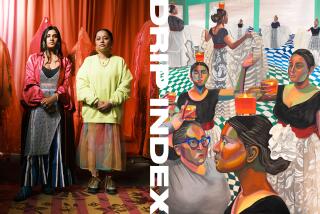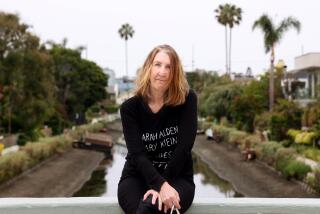Alexis Smith, collage artist uprooted
The artist’s studio is part factory, part chapel, part Merlin’s cave, reliquary and museum. Some artists say it doesn’t matter where they make art. Others claim their studio is their art. Some cities preserve studios, but L.A. does not. We worship artists; we trade real estate.
Sunday is the 30th annual Venice Art Walk & Auctions, when artists open their studio doors for the public to peek at sanctum sanctorums in houses, lofts and commercial buildings. However, there is one less studio to visit -- lost to gentrification, a byproduct of the venerable walk. It was the work space and home of collage artist Alexis Smith.
At 17, Patti Anne Smith reinvented herself as Alexis, taking the name of a fading movie star. With this new identify, Smith became a living collage, a layering of her original self and a celebrity she’d never met.
In the 1970s, as minimalism collided with conceptualism, Smith studied with Vija Celmins and Robert Irwin at UC Irvine. Recycling discarded matchbooks, clippings, menus, playing cards, license plates, movie posters, swizzle sticks and bowling balls, Smith pioneered an approach to assemblage, making collages and installations that comment on the moral lapses and flimsy psychology of American culture. Aphorisms attached to her work are by the famous and infamous, from Walt Whitman and Charlie Chan to Richard Nixon and Prince. They are cryptic, witty and poignant.
Venice at the edge of the Pacific was founded as an amusement park in 1904. By the late ‘60s it was run down, cheap and dangerous, ideal for artists, hookers and drug dealers. In 1972, working for an architect named Frank Gehry, Smith moved into a storefront loft at 1907 Lincoln Blvd. The open room had a vibe. It had just been the workshop of techno-wizard Jake Brogan, then formulating prototypes for Gehry’s cardboard tables and chairs.
Smith became a star of a generation that includes L.A. artists Barbara Haskell, Chris Burden, Mike Kelly and Carole Caroompas. It took a lot of stuff to keep shining. She hoarded finds from thrift stores, back alley garbage bins, roadside diners, hotels, motels and restaurants. Everything came back to the loft where she lived and worked, cooking up her meals and her art. For three decades, Smith created work for shows on both coasts, including a retrospective at New York’s Whitney Museum of American Art.
Piles in the studio grew until thousands of doohickeys and whatnots were spread over tables, floors, sofas, the kitchen counter and the sleeping loft. The place became a complex collage, designed with a byzantine logic known only to the artist, who was raised by her father, a psychiatrist, on the grounds of a mental hospital in Norwalk.
In 2005, with no warning, Smith’s landlord served notice. He had sold 1907 Lincoln to a real estate firm. Smith had 30 days to vacate. All that she knew, all that she was making, lay on the floor and counters of a studio that was no longer hers.
Four weeks later, Smith turned in her keys, and the studio’s ordered chaos was shipped to garages and warehouses. After decades of gluing things together for galleries and museums, Smith’s life was unglued. What remains of her spiritual home is the made-on-a-Mac booklet created by her husband, L.A. artist and sage Scott Grieger, with digital images he took just days before the movers arrived.
Today, 1907 Lincoln still stands, its studio space gutted for offices. Smith is back with two simultaneous solo shows in L.A. What does she think about her loss? When called for comment, her machine answered: “There are the known knowns and the known unknowns. And then there are unknown unknowns, the things that we don’t know that we don’t know. A little Donald Rumsfeld brought to you courtesy of Alexis Smith. Leave a message.”
For Watters’ past columns, go to latimes.com/lostla.
More to Read
The biggest entertainment stories
Get our big stories about Hollywood, film, television, music, arts, culture and more right in your inbox as soon as they publish.
You may occasionally receive promotional content from the Los Angeles Times.










